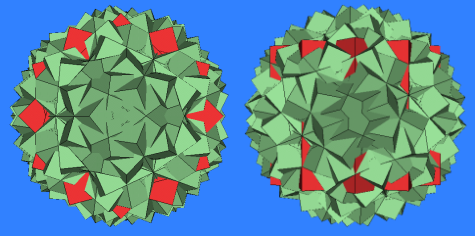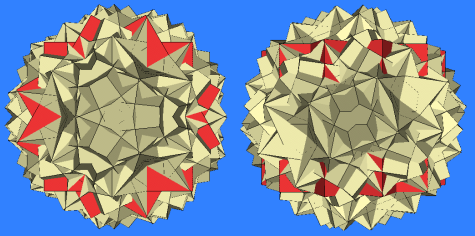Page 1 of 1
Posted: Wed Feb 20, 2008 11:57 am
by marcelteun
that someone actually went to the trouble of calculating (apparently without the benefit of a computer) and building paper models of all the figures
That is indeed amazing. The PC brought us many good things, but a part of the old fun is gone as well. As a student I found my first compound of twelve cubes and it took me more than half a year to calculate (using standard algebra) the shape of the individual pieces. After that I still didn't have any clue of how the polyhedron would look.
Then it took me a few more months to build a model. During that process I was happy to find out that I didn't make any (big) errors during the calculation and slowly I started to see how this compound looked. My point is that because of this long and slow process, the result was much more satisfying as well.
The comparison with mountain climbing is one that suits well here. You can take a lift up to a mountain and enjoy the view for while and then take the lift back to the village at the foot of the mountain, but if you climb a mountain yourself and enjoy the view, knowing that the only way to get this view is by hard work, you will notice that the experience is much more impressive. Not only the view, but the whole journey.
On the other hand I must say as well that I am very happy to be able to check quickly how my ideas will work out by using a computer...

Btw, here is the compound that I was talking of:

Challenging model
Posted: Thu Feb 21, 2008 7:03 am
by Dinogeorge
marcelteun wrote:As a student I found my first compound of twelve cubes and it took me more than half a year to calculate (using standard algebra) the shape of the individual pieces. After that I still didn't have any clue of how the polyhedron would look.
Then it took me a few more months to build a model. During that process I was happy to find out that I didn't make any (big) errors during the calculation and slowly I started to see how this compound looked. My point is that because of this long and slow process, the result was much more satisfying as well.
Btw, here is the compound that I was talking of:

This is a challenging model to reconstruct with Stella4D, but after an hour or two of fiddling around I finally got it. I also got this cute model (another compound of twelve cubes) on the way to finding yours:

Here's my Stella4D picture of your model:

Figuring out the coordinates of the vertices would require some heroic algebra indeed

Your model of twelve cubes is related to the first if my two models above in a surprising way. Care to take a stab at how?

Posted: Thu Feb 21, 2008 8:38 am
by marcelteun
The first model you show is a special position of 12A | S4 x I / C2 x I | μ , for which μ = acos(1/√3) such that it can be divided into 3 x 4 | D12 x I / D3 x I or into 4 x 3 | D12 x I / D4 x I
while the other one is a special version of 12B | S4 x I / C2 x I | μ , with μ = asin(1/√3) such that it can be divided into 4 x 3 | D12 x I / D4 x I.
So I can see that they are related because they are (special positions of) 2 different versions of a 12 | S4 x I / C2 x I and because they can both be divided into 4 x 3 | D12 x I / D4 x I. The algebraic expressions of the angles seem to be related as well.
Anyway, if you see another relationship, then "yes, please enlight me!"

BTW Thanks for mentioning this, I found a typo on my webpage at
http://www.tunnissen.eu/polyh/cubecmps. ... .S4xI.C2xI
Posted: Fri Feb 22, 2008 9:48 am
by Ulrich
marcelteun wrote: it took me more than half a year to calculate (using standard algebra) the shape of the individual pieces. After that I still didn't have any clue of how the polyhedron would look.
Then it took me a few more months to build a model.
Marcel,
I had an absolutely similar experience with my model of five tetrahedra which I calculated using sines, cosines and Pythagoras' theoreme and a pocket calculator. I was really satisfied when I saw the completed model.
Ulrich
Compounds of 12 cubes
Posted: Sun Feb 24, 2008 5:22 pm
by Dinogeorge
marcelteun wrote:The first model you show is a special position of 12A | S4 x I / C2 x I | μ , for which μ = acos(1/√3) such that it can be divided into 3 x 4 | D12 x I / D3 x I or into 4 x 3 | D12 x I / D4 x I
while the other one is a special version of 12B | S4 x I / C2 x I | μ , with μ = asin(1/√3) such that it can be divided into 4 x 3 | D12 x I / D4 x I.
So I can see that they are related because they are (special positions of) 2 different versions of a 12 | S4 x I / C2 x I and because they can both be divided into 4 x 3 | D12 x I / D4 x I. The algebraic expressions of the angles seem to be related as well.
Anyway, if you see another relationship, then "yes, please enlight me!"

BTW Thanks for mentioning this, I found a typo on my webpage at
http://www.tunnissen.eu/polyh/cubecmps. ... .S4xI.C2xI
Well, if by this you mean that one compound is obtained from the other by simultaneously rotating the four groups of three cubes about their common axes of symmetry through an angle pi/12, then you've got it

And thanks for the downloads of all those compounds (elsewhere at this forum)


Posted: Mon Feb 25, 2008 3:08 am
by marcelteun
Well, if by this you mean that one compound is obtained from the other by simultaneously rotating the four groups of three cubes about their common axes of symmetry through an angle pi/12, then you've got it Exclamation
Aha!... Of course, that is completely logical and there are probably more such connections between other A and B versions.
And thanks for the downloads of all those compounds (elsewhere at this forum)
My pleasure.
Posted: Mon Feb 25, 2008 9:19 am
by marcelteun
Yes, it seems that the same holds for
30A | A5xI / C2xI | mu9 and
30B | A5xI / C2xI | mu3 (the names link to VRML models for which a special player is required):


Posted: Mon Feb 25, 2008 12:38 pm
by robertw
Posted: Fri Feb 29, 2008 9:55 am
by marcelteun
Just want to mention that I fixed this




